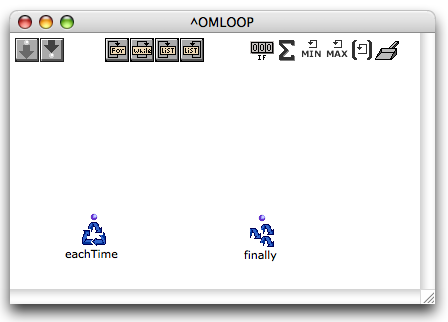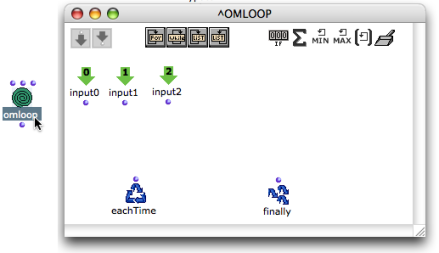General Features
| The OMLoop module is a specific type of abstraction – or patch. It encloses a number of specialized components, which allow to design iterative programs. Programming takes place in the internal editor of OMLoop. |
OMLoop Editor and Components
To open the OMLoop editor, double click on the OMLoop box.

OMLoop provides three types of programming components :

iterators : determine and stop the iteration process.
accumulators : gather the result at each step of the iteration in the ongoing process until the iteration is over.
Iterators and accumulators are visible at the top of the OMLoop editor and can be added with a click. The choice of iterators and accumulators depends on the iteration program.
evaluators : trigger the evaluation and return the results, at each step or at the end of the iteration.
The eachtime and finally evaluators are essential components which are displayed by default in the editor. Initdo can be added typing its name in the editor.
Adding Inputs and Outputs
| Initially, the OMLoop box has only one output and no input : programming can be done without the use of external data, like with a patch. Additional outputs and inputs can be added using the following procedures. |
| Inputs transfer incoming data to the programming functions of OMLoop. They are represented green top-down arrow inside the editor. |

 | To add or delete an input in the OMLoop box,
|
OMLoop outputs are managed with another procedure.
| The finally evaluator represents the visible output(s) of OMLoop. It returns the results of the iteration. Outputs can therefore be added and deleted by adding or deleting optional inputs to and from Finally. |
| To add or delete inputs to finally :
|
| Outputs also represented on the OMLoop icon once added. |
An OMLoop can't be evaluated from the inside of its editor. It will be ineffective until its internal program is defined correctly.
Do not evaluate it before it is completed : an infinite loop might get OM stuck for a while...
